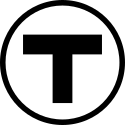MBTA
 |
|

The MBTA provides services in five different modes (boat not pictured) around Greater Boston.
|
|
| Overview | |
|---|---|
| Locale | Greater Boston |
| Transit type | |
| Number of lines |
|
| Number of stations |
|
| Daily ridership | 1,277,200 (weekday, Q4 2015) |
| Chief executive | Brian Shortsleeve (interim) |
| Headquarters |
|
| Website | mbta |
| Operation | |
| Began operation |
|
| Operator(s) |
|
| Technical | |
| System length |
|
| Track gauge | 4 ft 8 1⁄2 in (1,435 mm) |
The Massachusetts Bay Transportation Authority (abbreviated the MBTA and The T) is the public agency responsible for operating most public transportation services in the Greater Boston, Massachusetts region. Earlier modes of public transportation in Boston were independently owned and operated; they were first folded into a single agency with the formation of the Metropolitan Transit Authority (MTA) in 1947. The original MTA was replaced with the present-day MBTA in 1964, which was established as an individual department within the Commonwealth of Massachusetts before becoming a division of the Massachusetts Department of Transportation (MassDOT) in 2009.
The MBTA and Philadelphia's Southeastern Pennsylvania Transportation Authority (SEPTA) are the only U.S. transit agencies that operate all five major types of terrestrial mass transit vehicles: light rail vehicles (the Ashmont–Mattapan High Speed and Green Lines); heavy rail trains (the Blue, Orange, and Red Lines); regional rail trains (the Commuter Rail); electric trolleybuses (the Silver Line); and motor buses (MBTA Bus). In 2008, the system averaged 1.3 million passenger trips each weekday, of which the subway averaged 598,200, making it the fourth-busiest subway system in the United States. Further, the Green Line and Ashmont–Mattapan High Speed Line comprise the busiest light-rail system in the U.S., with a weekday ridership of 255,100.
...
Wikipedia
